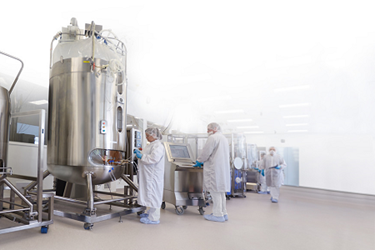Applications For Single-Use Systems In Biosimilar Development
By Jerry Martin

The current processing paradigm of large manufacturing facilities dedicated to single-product production is no longer an effective approach for best manufacturing practices. Additionally, in recent years, patents on several blockbuster biologics have expired, which means leading pharmaceutical companies can no longer charge a premium for these products. The expiration of major patents will leave an estimated $60 billion in drug sales from leading pharmaceutical companies at risk for competition.1 The subsequent launch of biosimilar drugs, which can be sold at a lower cost, has put pressure on manufacturers to lower production spending in order to stay competitive.
In the United States, biologics account for 40 percent of prescription drug spending, but only 5 percent of the population uses biologics.2 The cost of these medications is rising quickly, with some drugs costing as much as $50,000 per treatment, and high costs will likely become more problematic as the global population grows and new biologic therapies are introduced. As a result, many governments are passing legislation aimed at lowering the costs of follow-on biologics such as biosimilars.
Single-use systems are ideal for multi-product manufacturing facilities, especially where process steps may differ. They eliminate contamination crossover, changeout time, and downtime for cleaning and sterilization between batches and products. Therapeutic developers are increasing their use of single-use systems for clinical batches, and many will continue at production scale as batch sizes become smaller.
Counting The Benefits Of Single-Use
Single-use bioreactors operate at a smaller scale than traditional stainless-steel equipment used in large-scale monoclonal antibody manufacturing. The largest single-use bioreactors are only about 2,000 liters, while stainless-steel bioreactors generally process 10,000 to 20,000 liters each. Therefore, the primary savings benefit of single-use systems for biosimilar development is the reduced cost for process development and clinical trials. By changing out presterilized single-use bags between product batches, manufacturers can eliminate the risk of inter-batch contamination from more difficult to manage in-house sterilization processes. Single-use systems also have applications in formulating and filling operations, moving purified biosimilar drug substances to the formation container.
Single-use technologies offer savings in cleaning expense, especially purified water and WFI usage and have demonstrated greater safety without endangering environmental efforts compared to stainless-steel systems. By implementing single-use systems, manufacturers can avoid issues related to cross contamination between batches and products. Cross contamination is a risk with all bioprocessing equipment that is reused, including piping, tanks, mixers, and bioreactors. Cleaning validation for such equipment is expensive and time-consuming.
Single-use systems reduce costs associated with cleaning, maintenance, and assembly, minimize operator exposure, and free facility resources for other activities. Eliminating user-managed cleaning and sterilization reduces the need for a utility system and piping within a facility, leading to faster facility build time and lower capital cost. Establishing a single-use-enhanced facility takes about half to a quarter of the time that it takes to install a stainless-steel facility.
Making The Switch To Single-Use
The nature of single-use technology means that the risk of cross contamination is significantly lower; however, it is still important to conduct a comprehensive risk assessment when considering implementing a new system. There is also a case to be made for hybrid facilities that use stainless steel for non-product-contact equipment, such as media and buffer preparation.
Although single-use components might seem to be less sustainable than reusable ones, single-use systems have a lower environmental impact because of the reductions in the high-purity water and heat needed to clean and sterilize traditional systems. Single-use systems still present waste management challenges, however, as manufacturers must determine the best way to dispose of single-use components that may have come in contact with biological materials. Some disposal options include landfill, waste-to-energy incineration, and mixed-plastic recycling. Other considerations for implementing single-use systems are the security of supply, change management, and inventory management.
Navigating The Regulatory Environment
When developing biosimilars, manufacturers look to copy legacy processes in order to minimize differences between old and new drugs and avoid regulatory challenges, especially related to cleanliness. Because single-use systems were not used to develop legacy biologics, manufacturers of biosimilars may see implementing single-use as a regulatory risk. However, the FDA’s guidance for good manufacturing practice for Phase 1 investigational drugs acknowledges that preassembled, presterilized, closed disposable systems provide higher aseptic safety assurance.3 Prior to the release of this guidance in 2008, most single-use systems in use were being used to process preexisting drug products.
Concerns about extractables and leachables can also pose a barrier to implementing disposable technologies. While there is clear regulatory guidance around what is required by regulatory authorities (demonstration of product quality and safety), there is limited or no information on how companies should do this. The BioPhorum Operations Group offers a risk evaluation guide focusing on risk assessment, leachables study design, and analytical methods. New standards are being introduced by USP.4 Manufacturers can also turn to third-party resources such as the Bio-Process Systems Alliance (BPSA) for guidance in navigating FDA regulations in context of single-use systems.
Looking Forward
Despite these hurdles, the many benefits of single-use systems will make them an attractive choice for manufacturers as first-generation and next-generation drugs, or bio-betters, are introduced to the market. As originator drug batches get smaller and are made in single-use systems, biosimilars will follow suit. Newer processes have increased productivity tenfold, eliminating the need for 10,000- to 20,000-liter bioreactors and broadening applications for single-use bioreactors.
References:
- https://pmmi.org/report/2018-pharmaceutical-packaging-processing-white-paper
- https://www.ncbi.nlm.nih.gov/pmc/articles/PMC4990569/
- https://www.fda.gov/regulatory-information/search-fda-guidance-documents/current-good-manufacturing-practice-phase-1-investigational-drug
- https://www.biophorum.com/download/best-practices-guide-for-evaluating-leachables-risk-from-polymeric-single-use-systems/
Photo courtesy of GE Healthcare Life Sciences
About The Author:
 Jerry Martin is an independent consultant to pharmaceutical manufacturers and equipment suppliers for filtration, single-use manufacturing, marketing, business development, and regulatory compliance. He was previously SVP, marketing and global scientific affairs, for Pall Life Sciences, where he served the pharmaceutical, biotech, medical device, and vaccine industries for over 37 years. He is currently chairman emeritus of the Bio-Process Systems Alliance, the single-use manufacturing trade association, and a member of the USP Expert Panel on Plastic Systems Used for Manufacturing Pharmaceutical Products. He holds an M.Sc. in microbiology from the University of Toronto.
Jerry Martin is an independent consultant to pharmaceutical manufacturers and equipment suppliers for filtration, single-use manufacturing, marketing, business development, and regulatory compliance. He was previously SVP, marketing and global scientific affairs, for Pall Life Sciences, where he served the pharmaceutical, biotech, medical device, and vaccine industries for over 37 years. He is currently chairman emeritus of the Bio-Process Systems Alliance, the single-use manufacturing trade association, and a member of the USP Expert Panel on Plastic Systems Used for Manufacturing Pharmaceutical Products. He holds an M.Sc. in microbiology from the University of Toronto.
Biosimilar manufacturers looking for guidance in implementing and validating single-use systems can see solutions from more than 250 exhibiting companies at Healthcare Packaging EXPO (Sept. 23-25, 2019, Las Vegas Convention Center), co-located with PACK EXPO Las Vegas.
